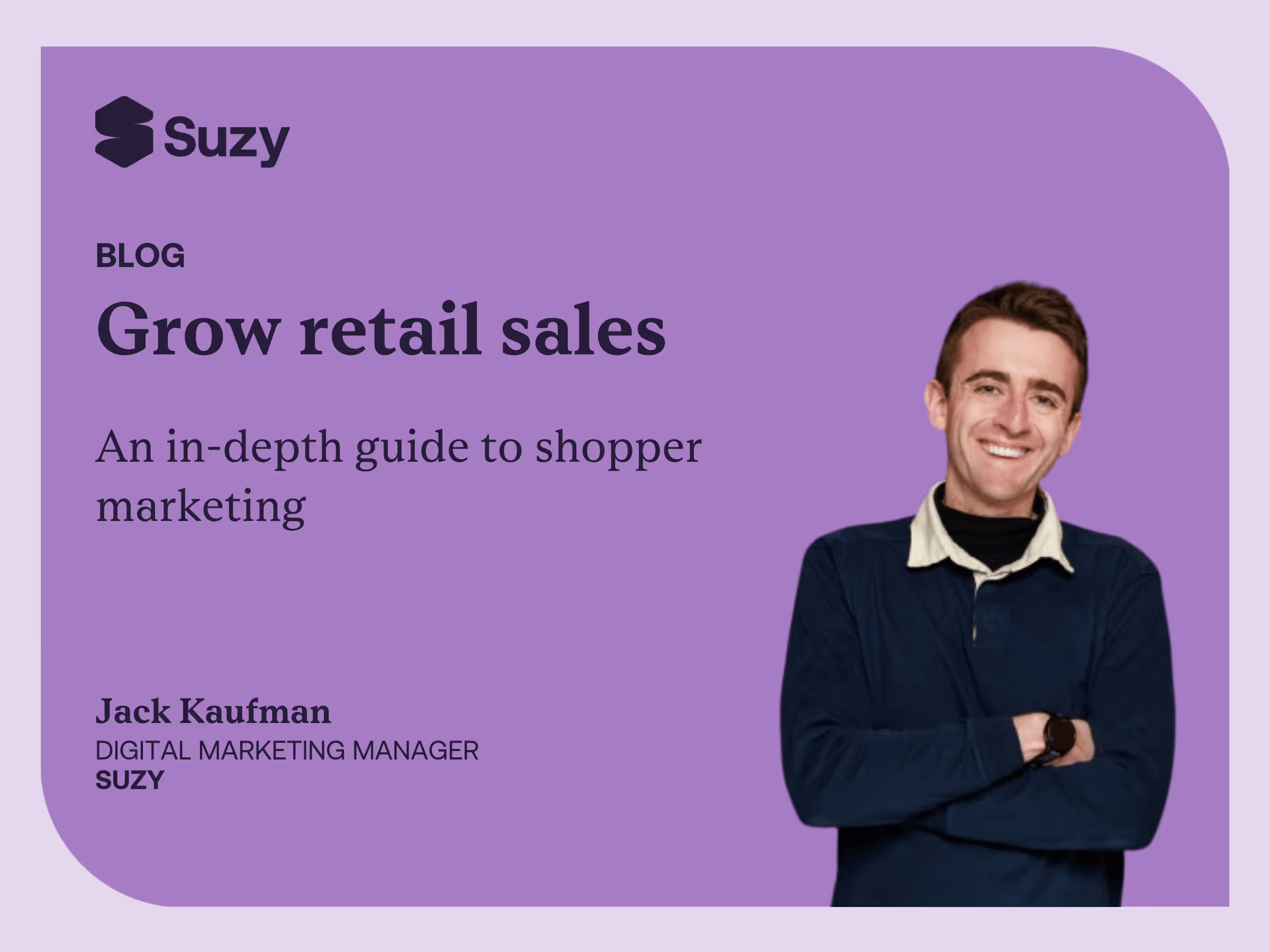By: Jack Kaufman, Digital Marketing Manager
Choices define every one of my visits to the grocery store or other retailers. Should I buy the Tillamook ice cream (a personal favorite) or go with Häagen-Dazs (on sale)? Will it be Ocean Spray (brand name) or private label (cheaper) cranberry juice this time? Should RX Bars, Perfect Bars, or both be my on-the-go snack?
These choices define every trip you make to any retailer. Whether you know it or not, brands use a variety of strategies and tactics from shopper marketing to encourage you to pick them.
Shopper marketing focuses on this moment of choice. Unlike brand advertising that builds long-term equity, shopper tactics drive conversion now. You compete not just with rivals on the shelf but also with distractions on phones. This guide gives you practical principles and examples so you can grow retail sales tomorrow, even with tight budgets and time.
Table of contents
Foundations of shopper marketing
Shopper marketing is the discipline of driving conversion by engaging people when they shop, both in-store and online. In physical retail it includes displays, shelf signs, secondary placements, and packaging cues. In ecommerce it covers search optimization, product page content, ratings and reviews, and retail media ads. The common thread is targeting the point of purchase, not long-term brand image.
Why shopper marketing matters
Small improvements at the shelf often move more revenue than large awareness campaigns. A two-percentage-point lift in conversion for a high-velocity SKU can add millions of dollars without increasing media spend. As retailers collect richer data, they sell targeted ads and demand higher standards of execution.
Marketers who master shopper tactics earn better placement, higher digital rank, and stronger retailer relationships. McKinsey calls these “moments that most influence their [consumers’] decisions,” noting that brands capturing them grow twice as fast as peers.
Industries and companies that use shopper marketing
- Food & beverage: Coca-Cola tests shelf merchandising in small store pilots before national rollouts, pairing endcaps with store app coupons. Many leading food and beverage brands like PepsiCo and Kraft Heinz use Suzy to test packaging design, shelf messaging, and promotional tactics with their core consumers.
- Beauty: Sephora integrates QR codes on shelf talkers that open tutorials and allow instant online purchase if a shade is sold out. Top beauty companies such as L’Oreal and The Estée Lauder Companies use Suzy to evaluate display and product visuals for both in-store and digital channels.
- CPG: Procter & Gamble uses “mission-based” bundles – laundry pods plus scent boosters – both in club pallets and digital kits. Many top CPG brands like Unilever rely on Suzy to understand shopper missions, optimize bundling strategies, and validate product claims.
- Consumer Electronics: Best Buy positions live demos next to shoppable videos on its site, shortening evaluation and conversion. Major consumer electronics brands such as Google and HP use Suzy to test digital shelf layouts, feature prioritization, and content formats that influence purchase decisions.
These examples show that shopper marketing applies beyond fast-moving consumer goods. Any category where the consumer decides in minutes can benefit.
Roles involved in shopper marketing
|
Role
|
Core Responsibility
|
|
Shopper Marketer
|
Plans programs, briefs creative, owns performance scorecard
|
|
Sales Account Lead
|
Sells programs to buyer, negotiates funding and space
|
|
Trade Marketing Manager
|
Aligns price and promotion calendars
|
|
Category Manager (Retailer)
|
Approves assortment, shelf flow, and metrics
|
|
Retail Media Manager
|
Buys onsite, offsite, and in-store ads
|
|
Insights Analyst
|
Provides mission, path, and conversion data
|
| Supply Planner |
Aligns inventory and promotion demand |
Back to table of contents.
Shopper marketing strategies and tactics
Shopper marketing lives on two levels. Strategies set direction; tactics deliver action and results. A solid strategy chooses why and where to play, while good tactics handle how to win the basket. Treat them like two gears of the same machine.
High-Level Strategies
These five strategies can guide any winning program. Use them as a checklist before spending a dollar.
- Mission targeting
Focus on the shopper’s purpose: stock-up, fill-in, treat, or discovery. Tailor pack sizes, messaging, and offers to fit that mission. A stock-up shopper wants value multi-packs, while a treat shopper responds to indulgent singles. - Omnichannel consistency
Show the same benefit, hero image, and price in store, on retailer sites, and in offsite ads. Consistency speeds recognition and trust. Brands use Suzy’s heatmapping to test product visuals and page content so assets resonate consistently across every channel. - Retailer scorecard alignment
Pitch programs that raise the metrics the retailer tracks—traffic, basket size, margin, or loyalty sign-ups. Alignment unlocks better placement and incremental media. With Suzy Insights, teams validate which messages move the retailer’s KPIs before walking into the pitch. - Test-and-scale
Pilot in a small number of stores or one ecommerce banner, measure lift, refine, then roll out nationally. Rapid iteration lowers risk and improves every wave. - Data-driven personalization
Use retailer audiences to serve different messages to lapsed, loyal, or new shoppers. Personalization boosts relevance without ballooning creative costs. Suzy Speaks uncovers the “why” behind different shopper segments so you can tailor messages with confidence.
What to do next
Pick your next launch and confirm it satisfies at least three of the five strategies above.
Proven tactics
Strategies set the compass, but tactics pull the shopper’s hand toward your product. Each tactic below can inform your shopper marketing plan.
In-store tactics
- Endcaps – High-traffic real estate lifts awareness and conversion. A cookie brand doubled weekly sales by funding a four-week endcap with bright benefit messaging. Suzy’s heatmapping helps brands pre-test endcap signage and design to ensure claims and visuals break through.
- Power wings – Clip-strip or sidekick displays placed near complementary items.
- Floor decals – Directional graphics lead shoppers to new items, adding discovery without extra shelf space.
- Shelf talkers – Five-word benefit, hero image, and price circle. Shoppers scan in two seconds; keep text tight.
- Secondary coolers – Chilled single-serve beverage coolers in center store create impulse stops that can lift unit sales.
- Associate sampling – Live demos with a clear call to “shop the endcap now” create immediate lift and drive social media mentions when paired with a hashtag. With Suzy Speaks, brands capture real shopper reactions to sampling programs and understand the “why” behind what drives conversion.
Ecommerce tactics
- Optimized titles – Use Brand + Need + Size. “PureGlow Vitamin C Serum 1 oz” ranks higher than “Vitamin C Serum.”
- Bullets that sell – Need, benefit, proof. Three bullets cover eighty percent of shopper scanning.
- Enhanced images – Front, back, lifestyle, ingredient callout, and size comparison. More angles build trust and reduce returns.
- Video demos – Thirty-second clips with captions raise add-to-cart rates, especially in beauty and small appliances.
- Ratings and reviews seeding – Sampling programs that secure fifty reviews quickly trigger algorithm preference.
- A/B asset tests – Swap image order or headline phrasing on half of traffic to learn what converts fastest. Brands use Suzy Insights to simulate these tests in-platform and predict what assets will convert.
- Persistent promo tags – Deal badges that follow the product across site pages remind shoppers of value every step.
Retail media tactics
|
Placement
|
Purpose
|
Example |
Tip |
|
Offsite Display
|
Awareness |
Retarget category browsers on lifestyle sites
|
Cap frequency at ten per week
|
|
In-Store Screens
|
Consideration |
Loop silent demo near fragrance counter
|
Swap creative every two weeks
|
|
Onsite Sponsored Products
|
Conversion |
Bid on “sparkling water” for new flavor launch
|
Pause bids if inventory <95%
|
Promotion tactics
- Threshold offers – “Spend $30, save $5” drives larger baskets in stock-up missions.
- Bundles – “Shampoo plus conditioner 25 percent off” increases units per trip and trial of secondary SKUs. Suzy’s platform enables fast testing of bundle messaging and pricing to validate impact before launching in market.
- Flash discounts – One-day online price drop clears slow inventory without training shoppers to wait for deals.
- Loyalty-only coupons – Member-exclusive pricing cements repeat purchase and grows retailer card sign-ups.
What to do next
Pick three tactics that fit your primary shopper mission and plan small tests for each of them.
Back to table of contents.
Using market research and consumer insights to improve shopper marketing
A successful program starts with facts, not hunches. Good research tells you who buys, why they buy, and how they move from trigger to transaction. Great research then feeds back into better creative and tighter execution.
Understanding and predicting shopper behavior
Shoppers say one thing in surveys and often do another at the shelf. Combine two research streams to bridge the gap: attitudinal and behavioral.
- Attitudinal research – Surveys and diaries reveal motivations, perceived barriers, and mission split. Suzy Speaks gives brands a conversational way to capture authentic motivations and barriers in shoppers’ own words.
- Behavioral research – Receipt panels, path tracking, and clickstream data capture real choices and timing.
When you layer motivations on actual actions you uncover insight. For example, receipt data showed a spike in disinfectant wipes during mid-week “fill-in” trips, while surveys revealed parents aimed to clean lunchboxes. Together this insight led to cross-aisle power wings near school snacks, lifting wipes sales.
Understanding path to purchase and optimizing it with research
A path to purchase maps each touchpoint from need to loyalty. To optimize:
- Measure drop-offs – Track how many shoppers leave at each stage: search, product page, cart, checkout.
- Match tactics to stage – Use awareness media early, conversion media later.
- Remove friction – Fix stock gaps, slow page loads, or confusing price bundles.
- Close the loop – Post-purchase how-to emails improve satisfaction and encourage reviews.
Suzy Signals helps marketers connect the dots by delivering actionable next steps after every study, tying shopper research directly to execution at each stage of the journey.
Improving purchase funnels
A purchase funnel quantifies the shopper journey:
- Page views – Reach of product pages.
- Add-to-cart rate – Persuasiveness of content and price.
- Checkout completion – Trust in payment and shipping.
- Repeat rate – Long-term loyalty.
Suzy makes it possible to A/B test creative, claims, and imagery with shoppers before rolling into live funnels.
Turning Insights into Action
An insight is only valuable when it changes what a shopper sees, hears, or pays. Move from “interesting” to “implemented” with a structured loop you can repeat on a regular cadence.
- Distill
Write a one-sentence insight that anyone can understand. Keep it under twenty words and tie it to a single data point.
Example: “Mid-week fill-in trips drive thirty percent of disinfectant wipe sales.” - Design
Turn the insight into a testable solution. Pick one variable to change and one metric to watch.
Example: Place wipe clip strips near school-lunch snacks and track unit lift versus control stores. - Deliver
Brief every team involved—sales, creative, supply, media—using the One-Page Insight Brief. Host a fifteen-minute huddle to confirm owners and deadlines. - Document
Collect results in a shared dashboard within seven days of test end. Show raw numbers, percentage lift, and confidence range. Flag data gaps, such as stores that missed set-up. - Decide
If lift exceeds the preset goal and confidence is high, scale the tactic. If results fall short, log the learning and pivot the variable for the next test.
Suzy empowers this loop by uniting quant from Insights with qual from Speaks and Live, and using Signals to recommend the next best action.
Back to table of contents.
Shopper marketing case study: HIPPEAS snacks uses Suzy to validate shelf strategy and drive retailer sell-in
Challenge
HIPPEAS needed a new sub-brand to break through on shelf and resonate with new consumers –requiring confidence in flavor, name, packaging, and shelf presence before pitching to major retailers.
Solution
Using Suzy, HIPPEAS:
- Tested 10 flavor concepts for appeal, tastiness, and uniqueness
- Ran name and package design testing with target consumers
- Conducted a monadic shelf set test to compare new vs. existing packaging and competitors
Impact
The data enabled HIPPEAS to find two new flavors to launch with a new snack product, and they successfully launched it in Sprouts and Wakefern. Uncover the full impact Suzy had on HIPPEAS’ shopper marketing by downloading the complete case study.
Back to table of contents.
Take action now
Shopper marketing converts brand interest into revenue by owning moments of choice. Anchor programs in clear missions, support them with consistent omnichannel tactics, and fuel improvement with robust research. Those split-second Tillamook vs Häagen-Dazs, Ocean Spray vs private label, and RX Bars vs Perfect Bars decisions are exactly the moments to design for.
Small disciplined tests, measured precisely, scale into big gains over time. Start with one mission, pick three tactics, test fast, and refine relentlessly. Your shoppers, retailers, and bottom line will notice the difference. I certainly notice it as a shopper. Anytime I visit the grocery store, I always buy Ocean Spray cranberry juice over private label. Why? Because I associate its eye-catching packaging with a brand I trust.
Want to see how Suzy can help you test and scale your shopper strategy? Talk with our team to get started.
Book a Demo today
See Suzy in action. Learn how Suzy can boost your business.
.webp)





.png)

